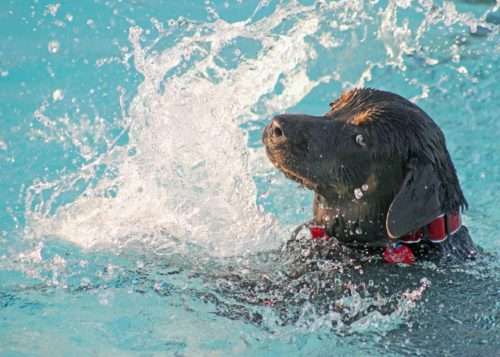As nearly any dog owner will agree, enjoying the great outdoors with your four-legged friend during the warmer months is one of life’s simple pleasures – from frolicking in the lawn sprinkler to fun-filled days at the park, making summertime memories with your beloved pooch is one of the great pleasures of being a pet parent.
However, it’s important to remember to use precautionary measures when you’re spending any length of time in the sun, especially on very hot days. Heat stroke in dogs is a very real condition, so knowing the signs and symptoms and educating yourself is essential to your furry friend’s health.
This article will review some simple steps you can take to protect your canine companion from the complications of heat stroke and how to identify if he’s overheating.
Did You Know…
Certain dog breeds are more prone to heat stroke, so be extra careful if you happen to have a brachycephalic breed – this terminology pertains to dogs that have a relatively short, broad skull. Such breeds include the Pekingese, Bulldogs, Boston Terriers, Pugs, Boxers, Cavalier King Charles Spaniels, and Shih Tzus, which are particularly sensitive to the extreme heat, since the shape of their skull (consequently affecting the sinuses) leads to respiratory distress.
Due to their normally diminished ability to take in oxygen as they breathe, high temperatures and bright sun can be dangerous for these breeds, as they can overheat quite easily.
Canine Heat Stroke: Identifying The Signs

Although the vast majority of dog breeds have some form of hair or fur that protects them against the colder temps, it often poses a problem for our pets in hot weather, especially for long-haired breeds. Also known as hyperthermia, heat exhaustion (or heat stroke, as it is most commonly referred to) is a dangerous but highly preventable condition.
As you may already know, dogs, unlike humans, eliminate heat primarily by panting and through the pads on their paws, not through sweat glands. Therefore, they are much more apt to overheat on a hot sunny day, since they also have a higher core body temperature and are unable to cool off easily.
Symptoms of heat stroke in your dog may include:
- Heavy panting
- Increased salivation/excessive drooling
- Signs of dehydration
- Increased body temperature (above 103˚ F)
- A reddened or pale appearance of the gums and moist tissues of the body
- Bright red tongue
- Bloodshot eyes
- Thick, sticky-looking saliva
- Production of only small amounts of urine/no urine
- Rapid heart rate
- Dizziness
- Weakness and/or lethargy
- Depression
- Vomiting blood
- Diarrhea
As heatstroke progresses in your dog, it can lead to seizures, coma, sudden (acute) kidney failure, cardiac arrest, and death.

Did You Know…
Because the majority of cases go unreported, there are no statistics on how many dogs tragically die every year from heat exhaustion. Your fur baby can suffer permanent damage (or even death) very quickly if left in a parked car on a hot day or kept outdoors without adequate shelter and defense from the sun.
Losing your pet to a heat-related death is totally preventable – never leave your dog in a parked vehicle for any amount of time, even if the windows are down and you’re in the shade. If you have an outdoor dog (or your pooch is spending more than a few minutes outside on a very hot sunny day), be sure to provide some form of shady area, such as a doghouse, umbrella, or other spot where he can get some relief and protection from the sun’s strong rays.
Prevention: How to Protect Your Dog From Heat Exhaustion
As is the case in nearly any situation, knowing is half the battle – learning how to prevent your dog from experiencing a heat stroke is simple once you understand the appropriate measures to follow during the height of summer. Using good old-fashioned common sense is one of the most effective ways to ensure your dog won’t suffer the complications of canine hyperthermia.
Here are a few helpful tips to prevent your beloved pooch from heatstroke:
Do…
Keep Water On Hand: Yes, it may seem obvious, but providing your pup with plenty of water at all times is one of the easiest ways to safeguard him from dehydration and heat exhaustion. Be sure to carry cool bottled water and a collapsible bowl during car trips, vacations and even walks around the neighborhood.
Provide Plenty Of Shade: For outside dogs, make sure they’ve got adequate protection from the sun – a doghouse, sun umbrella, overhang or other similar structure can make all the difference on a sweltering summer day.
Keep Him Cool: Moving your dog to a cool area in your home (preferably air-conditioned or in front of a fan) is a safe and easy way to prevent overheating. If you want to go one step further, freeze water in a clean, empty soda bottle, or place ice cubes in a Zip-lock baggie, then wrap in a tube sock, old t-shirt, or towel so your pet can lay on it. You can even throw a few large ice cubes in his water dish for added refreshment.

Give Him a Towel-Down: Wetting down your pal with a cool, damp towel or even a spray mist bottle filled with water is a great way to keep his core body temperature at a healthy level. If you’re by a swimming pool, beach, lake or even a sprinkler, encourage a swim (be sure to watch him carefully for safety reasons, of course) to keep him cool and comfy.
Dogs with Health Issues Need Extra TLC: For dogs with preexisting health conditions (such as heart disease, diabetes, obesity, or respiratory issues) as well as older dogs, taking extra precautionary measures to protect them against the perils of heatstroke is crucial – even routine activities can be strenuous for them during the warmer temperatures.
Check The Weather: Before planning any outdoor activities with your buddy, check the weather forecast, including the temperature and humidity levels. In addition, touch the pavement to see how hot it is – remember, your dog’s foot pads are sensitive and can be easily burned on the smoldering concrete. You may want to purchase booties to protect your dog’s paws during walks, particularly if you live in an urban area where grassy areas are at a minimum.
If You See Something, Say Something: If you happen to see a dog locked in a car on a hot day and you believe he’s in imminent danger, write down the make and model of the car, the license plate and a description of the animal. If you’re at a mall or shopping center, see if you can track down security and have them page the owner of the car on the PA system. Time is of the essence, as every minute that passes increases the risk of fatality. If you are not immediately able to access help, call the police department or local animal control for assistance.
Travel Smart: When your dog’s along for the ride, be sure that he’s well-ventilated and safe – he should be securely situated in a wire kennel (suitable for medium to large-sized dogs) or a crate (for smaller dogs). Once he’s outdoors, always make sure your pooch has access to plenty of clean water and a cool, shady spot.
Don’t…
Leave Them in a Parked Car: This cannot be stressed enough – even if you’re parked in the shade or going into the store for a few minutes, your car’s temperature can soar up to 140 degrees if not air conditioned. Therefore, never leave your pets in a car unattended for any length of time.
Engage in Strenuous Exercise & Physical Activity: It’s important to limit your dog’s physical activity on excessively hot days, as it can be a danger to his health. Do not take him jogging with you, and watch for signs of heat exhaustion when your dog is spending long periods of time outdoors. Instead, walks and play-time are best done during the earlier morning or in the evening when it’s cooler.
Muzzle Your Dog: Muzzling your dog during the hot summer months can impede his ability to pant (and therefore regulate his body temperature effectively). If you have a dog with aggression or behavioral issues that normally requires muzzling, taking him out in public settings during times of extreme heat may not be the best idea.
Remain in Hot Spots: Certain areas – such as the beach or outdoor locations with concrete/asphalt where the heat is reflected and there’s no access to shade – are very dangerous to your dog, so steer clear of them until the sun goes down.
What to Do If Your Dog Gets Heatstroke
In the unfortunate event that your dog (or someone else’s pet) is showing signs of heatstroke, remove the animal from the hot environment right away. If the dog is unconscious, be certain to prevent water from entering the mouth or nose as you follow the guidelines below:
- Place your dog in the bath tub (if a tub isn’t available, use a stall shower or shallow basin)
- Run a cool (not cold) shower over the animal, covering his entire body, particularly the back of the neck and head
- Allow the tub to fill up as you continue to shower the dog, keeping his head elevated at all times to prevent aspiration pneumonia
- If getting your dog into the tub isn’t feasible, use an outdoor garden hose to cool him down
- Apply a cold pack (such as a packet of frozen peas wrapped in a dish towel) to his head to lower his core temperature
- Massage your dog’s legs – by doing so, you can help increase circulation and prevent the risk of shock associated with hyperthermia
- Let your dog drink as much cool/cold water as he wants. Adding a pinch of table salt to the water bowl will help rehydrate him, as he’s lost crucial minerals from being dehydrated
- Do not to administer any aspirin or other medications to lower your dog’s temperature, as it can lead to further complications
- In addition, be sure to check your dog for signs of shock, and take his temperature every five minutes, continuing the water-cooling process as outlined above until his temperature drops below 103˚F. If his temperature drops a bit more (e.g., to around 100˚F), it’s ok; a slightly low temperature is much less dangerous
Your dog will require professional medical attention, so bring him to your veterinarian immediately. As mentioned earlier, heatstroke can cause unseen complications, such as swelling of the brain, renal (kidney) failure, and abnormal clotting of the blood.

During your trip in the car to the vet’s office, you can lower his temperature by placing cool, wet towels under his armpits, over his neck and between his hind legs; dampening his ear flaps and paw pads is also helpful. Keep the vehicle air conditioned with the windows cracked (or if you don’t have air conditioning, keep all of the windows down completely) and increase air movement around the dog with a fan if possible.
Be sure to use cool water, as very cold water can be dangerous. Even if he appears to be recovering, it’s essential for your dog to see a vet right away for an examination. By doing so, you can ensure he’s diagnosed and treated properly to avoid the complications associated with heat stroke and severe dehydration.
What to Expect at The Vet
Once you have brought your dog to the vet’s office, the treatment will primarily focus on replacing lost fluids and minerals. Depending on the severity of your pet’s condition, your vet will diagnose and treat your dog accordingly during the examination.
Typically, intravenous fluid therapy and monitoring your dog for secondary complications (such as changes in blood pressure, electrolyte abnormalities, kidney failure, abnormal clotting, or the development of neurological symptoms) are recommended in the cases of canine heatstroke. This is one visit to the vet that can truly save his life.




